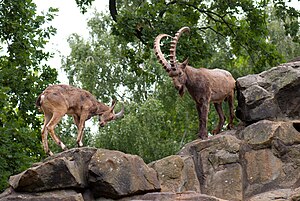Capra (genus)
|
Capra Temporal range: 2.6–0 Ma -Present |
|
|---|---|
 |
|
| Female and male Siberian ibex at the Berlin Zoological Garden | |
| Scientific classification | |
| Kingdom: | Animalia |
| Phylum: | Chordata |
| Class: | Mammalia |
| Order: | Artiodactyla |
| Family: | Bovidae |
| Subfamily: | Caprinae |
| Tribe: | Caprini |
| Genus: |
Capra Linnaeus, 1758 |
| Species | |
|
See text. |
|
 |
|
| Approximate range of the Capra species | |
See text.
Capra is a genus of mammals, the goats or wild goats, composed of up to nine species, including the wild goat, the markhor, and several species known as ibex. The domestic goat (Capra aegagrus hircus) is a domesticated subspecies of the wild goat (Capra aegagrus). Evidence of goat domestication dates back more than 8,500 years.
Wild goats are animals of mountain habitats. They are very agile and hardy, able to climb on bare rock and survive on sparse vegetation. They can be distinguished from the genus Ovis, which includes sheep, by the presence of scent glands close to the feet, in the groin, and in front of the eyes, and the absence of other facial glands, and by the presence of a beard in the males, and of hairless calluses on the knees of the forelegs.
The Rocky Mountain goat is in a separate genus, Oreamnos.
All members of the Capra genus are bovids (members of the family Bovidae), and more specifically caprids (subfamily Caprinae). As such they are ruminants, meaning they chew the cud, and have four-chambered stomachs which play a vital role in digesting, regurgitating, and redigesting their food.
The genus has sometimes been taken to include Ovis (sheep) and Ammotragus (Barbary sheep), but these are usually regarded as distinct genera, leaving Capra for goats and ibexes. In this smaller genus, some authors have recognized only two species, the markhor on one side and all other forms included in one species on the other side. Today, nine species are usually accepted:
The goats of the genus Capra have complex systematic relationships, which are still not completely resolved. Recent studies based on suggest that the Siberian ibex and the Nubian ibex represent distinct species, which are not very closely related to the physically similar Alpine ibex. The Alpine ibex forms a group with the Spanish ibex. The West Caucasian tur appears to be more closely related to the wild goat than to the East Caucasian tur. The markhor is relatively little separated from other forms—previously it had been considered to be a separate branch of the genus.
...
Wikipedia
